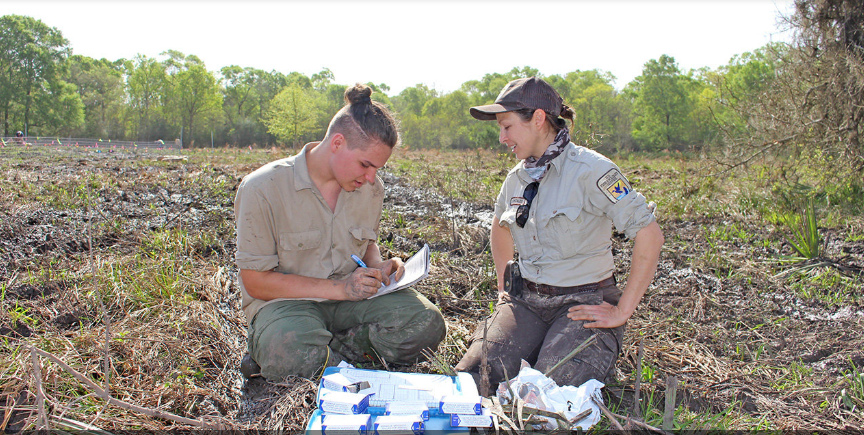Insights > Entergy Texas Supports Reforestation Project at Trinity River National Wildlife Refuge
Entergy Texas Supports Reforestation Project at Trinity River National Wildlife Refuge
06/13/2019

For research associate and intern Jake Ballard of Liberty, Texas, working in the wilderness is what he lives for.
When not attending Texas A&M University in Galveston, Ballard works alongside wildlife biologist Laurie Lomas Gonzales at Trinity River National Wildlife Refuge. They do everything from measuring tree growth and surveying birds to spraying herbicide and capturing feral hogs.
“This work is phenomenal. I’m able to take my passion and turn it into science,” Ballard said. “It calls me at night. It’s like breathing. I need it to live.”
On a sunny and very muddy spring day this year, nearly a dozen Entergy Texas employees volunteered in the research section of the refuge near Dayton.
Entergy Trees
Nearby, workers were planting 80,000 seedlings that were made possible in part by an environmental grant from Entergy Texas and support from The Conservation Fund and its corporate partners. The reforestation project is part of a multi-year initiative to restore 100 acres of bottomland hardwood forest with 45,000 trees.
“The area where we are working used to be a forest but was cleared and converted to a pasture in the 1990s,” Gonzales explained. “If we were to let it go fallow, it wouldn't convert back to the forest it was because the seed source in the pasture has changed.
“Two invasive species, Chinese tallow tree and trifoliate orange tree, have set their seed source in this field. By planting oaks, elms and pecan trees, we are giving these species a head start to try and out-compete the invasive species and regenerate the forest to a more natural composition,” she said.
Hog Research
Part of the project involves initiating a study to see how the seedlings and the forest regenerate over the next 8 to 10 years. Entergy volunteers helped finalize the study plots by building five exclosures using hog paneling and fencing to keep hogs from entering areas where trees were planted.
“We are curious to see how this new forest regenerates with and without the presence of hogs,” Gonzales said. “Hogs cause a lot of damage to forest soils. They root it up and actually cause changes in the chemistry and make it easier for Chinese tallow and trifoliate orange to invade. Also, hogs eat acorns and other native seed sources, changing the mix of species which regenerate as forests age. We want to see what will grow voluntarily and how seedlings will compete with that growth.”
Environmental Impact
While providing useful shade and shelter for animals, Gonzales said the trees help improve air quality and water quality and sequester carbon from the atmosphere. Their roots stabilize soil and help slow floodwaters. Also, acorns are a major food source for more than 100 species.
“You wouldn't think that insects, birds, squirrels, deer and hogs all share a food source, but they sure do,” she said. “Even Native Americans depended on the nutrient content of acorns. In that seed is a lot of carbohydrates, protein, and fat -- the building blocks of a tree.”
Entergy Corporation recently announced new steps it is taking to bring value to customers while supporting a lower carbon future and communities that are more sustainable and resilient. To learn more, see our latest report.

